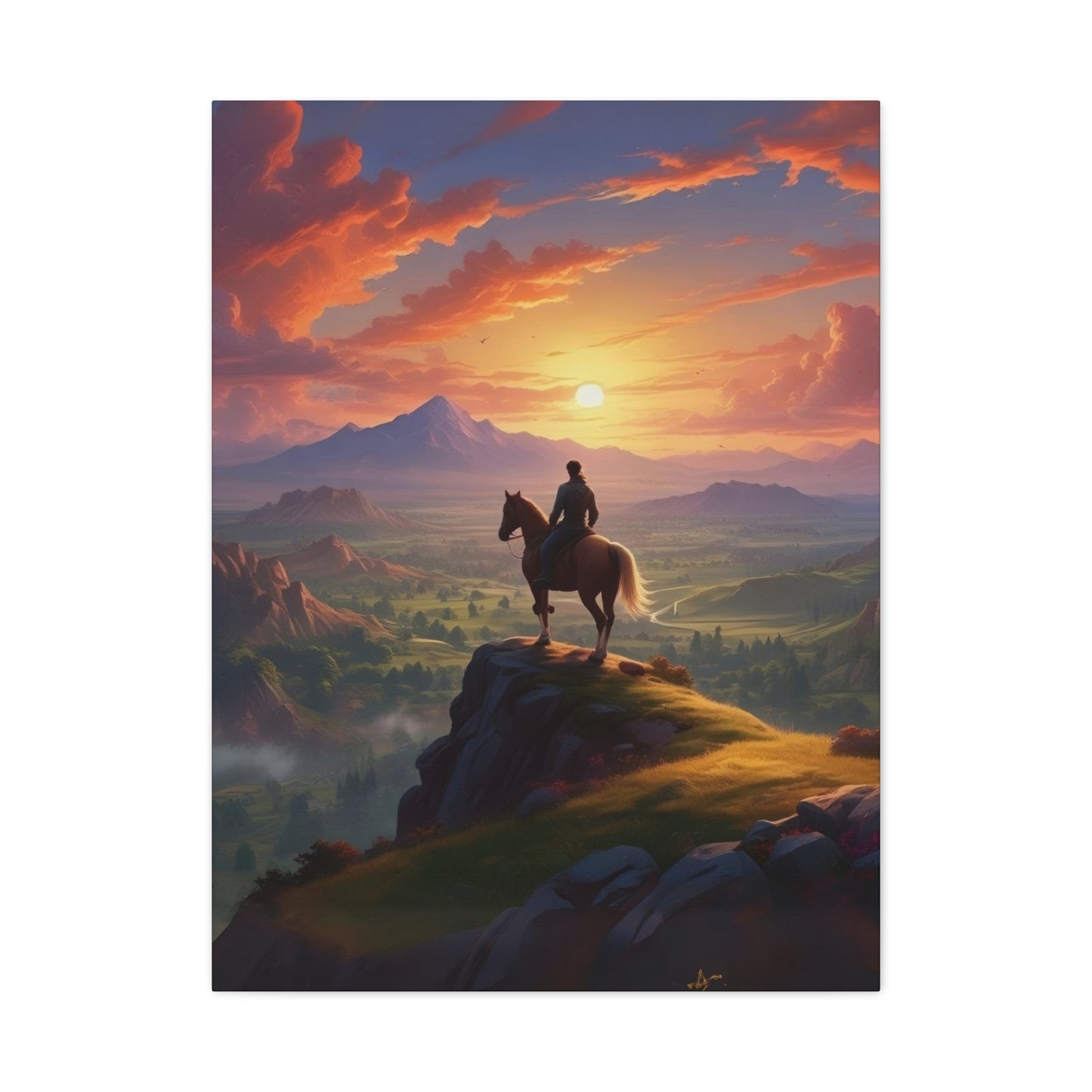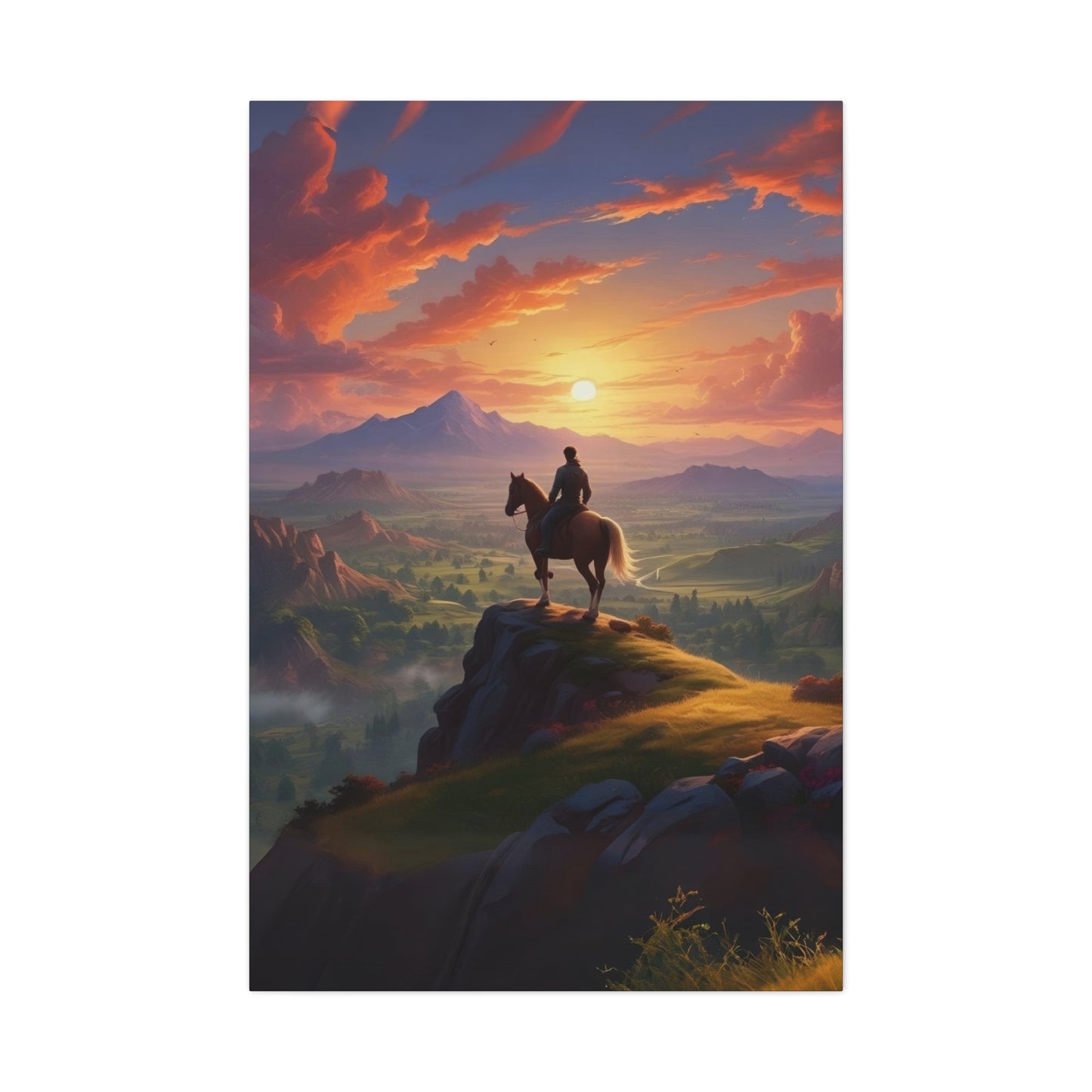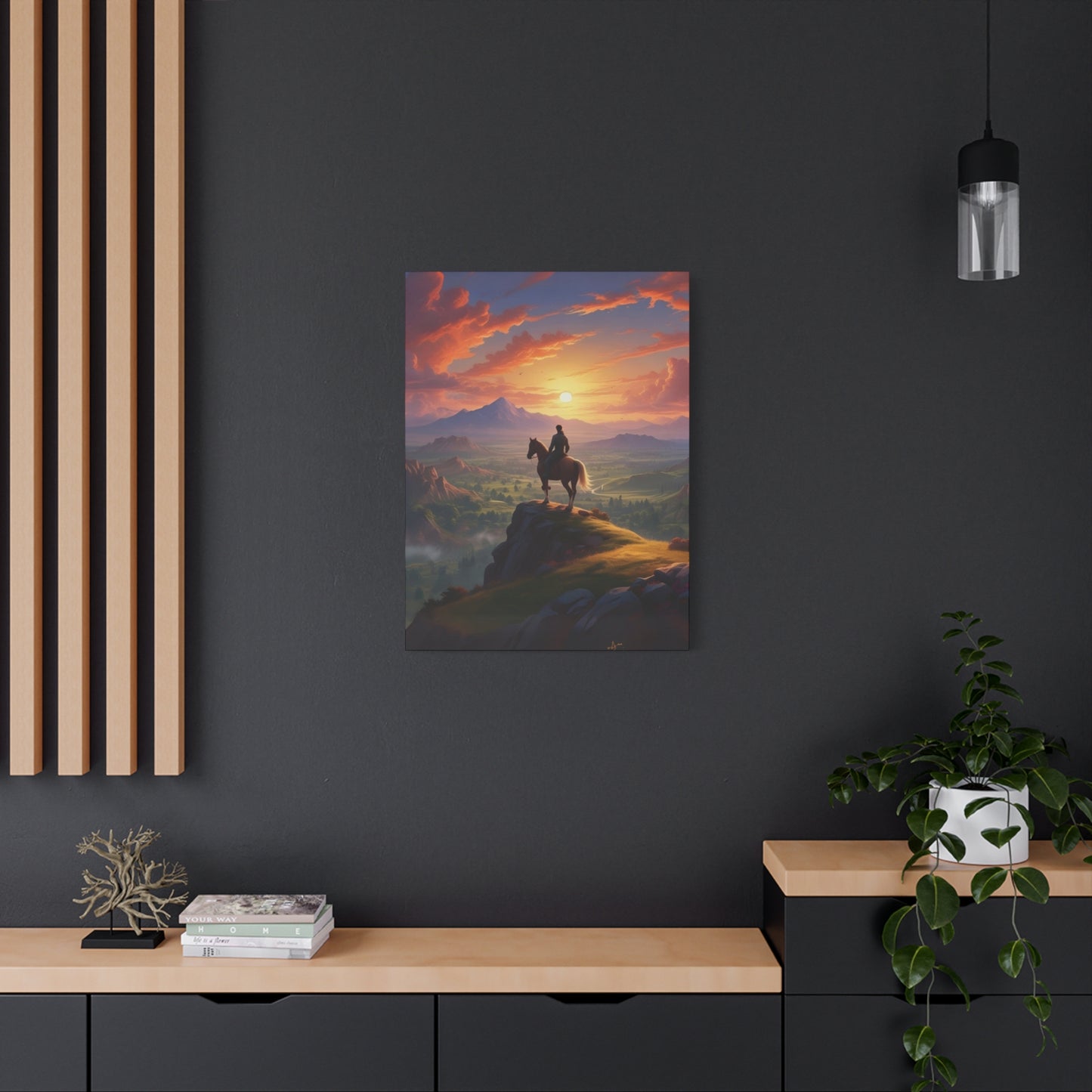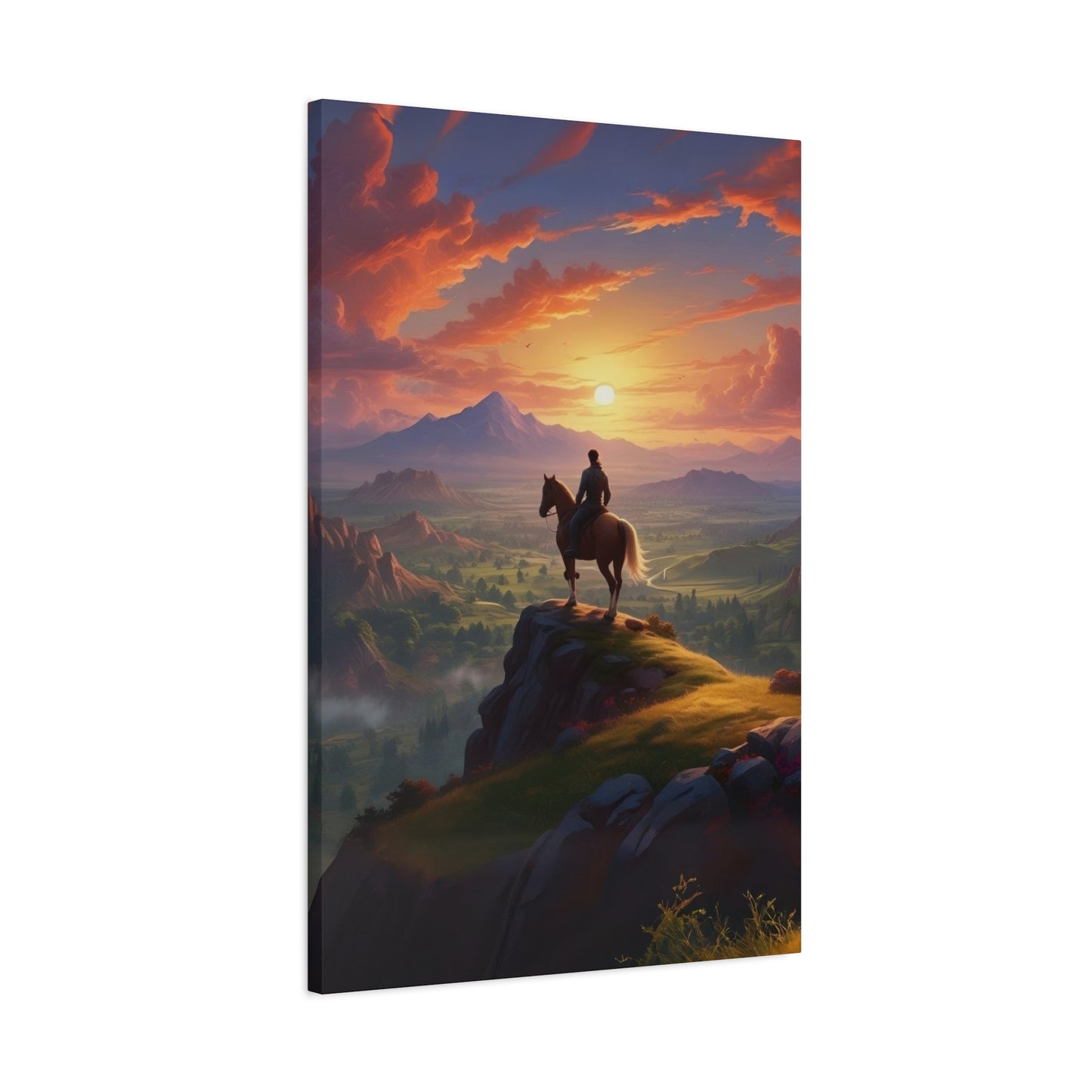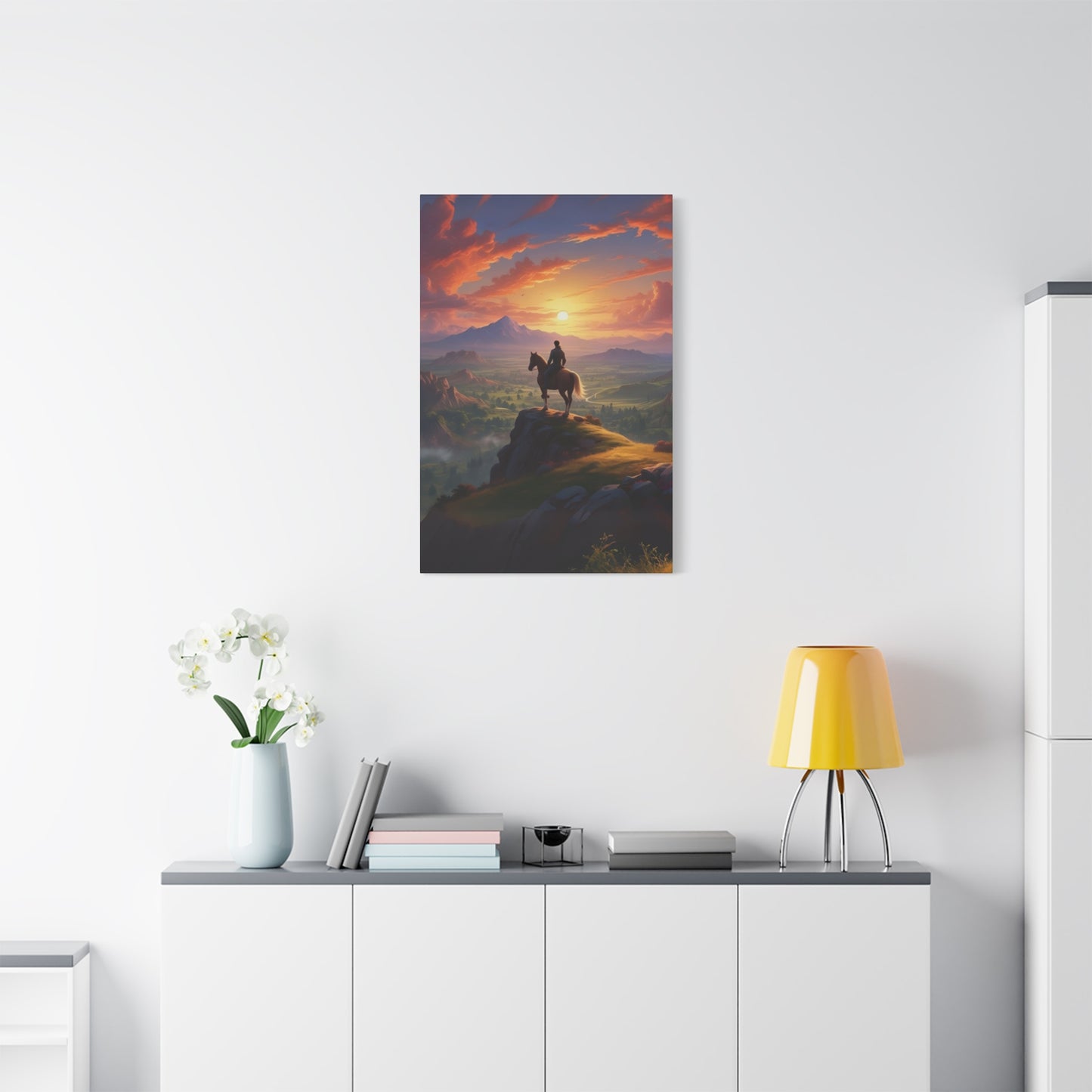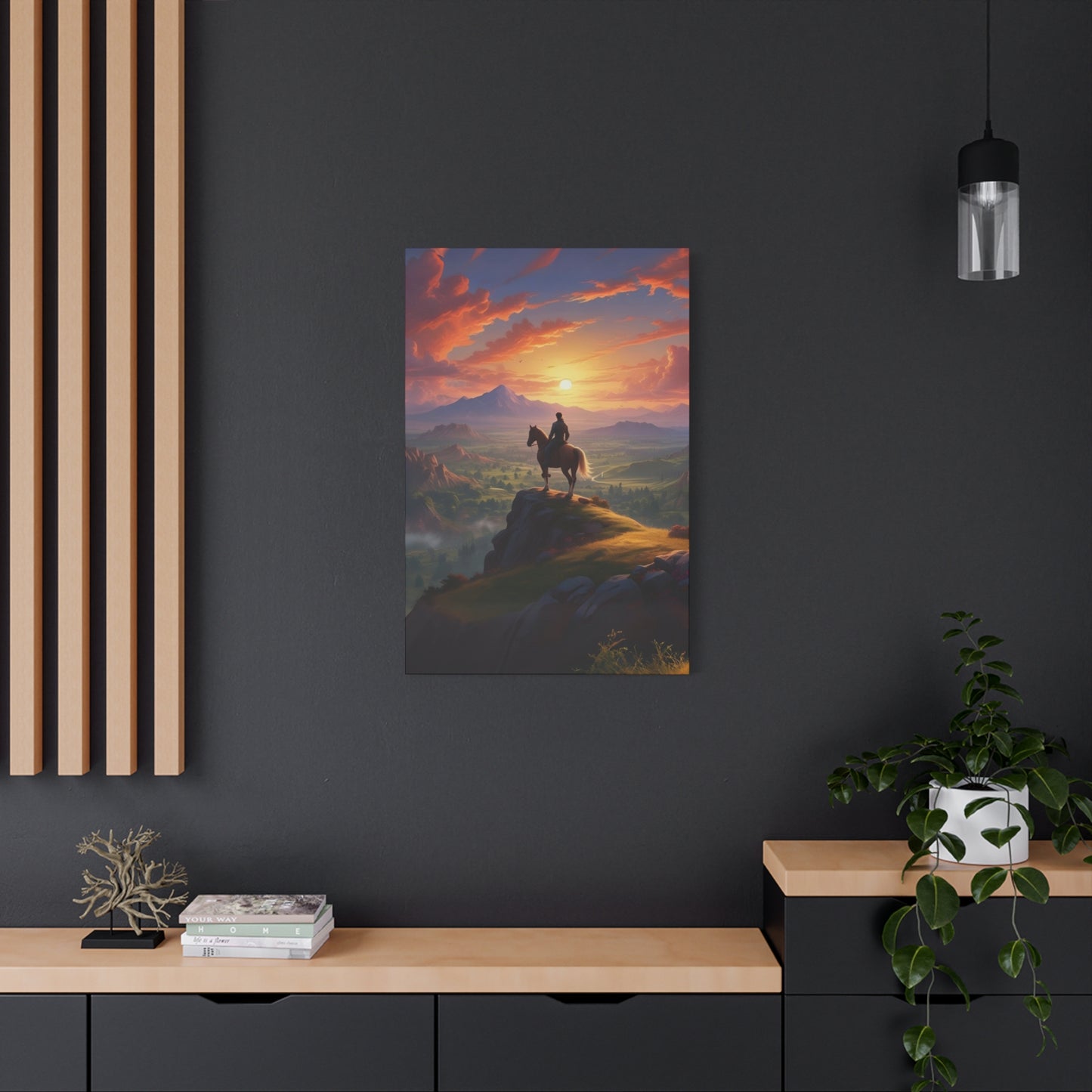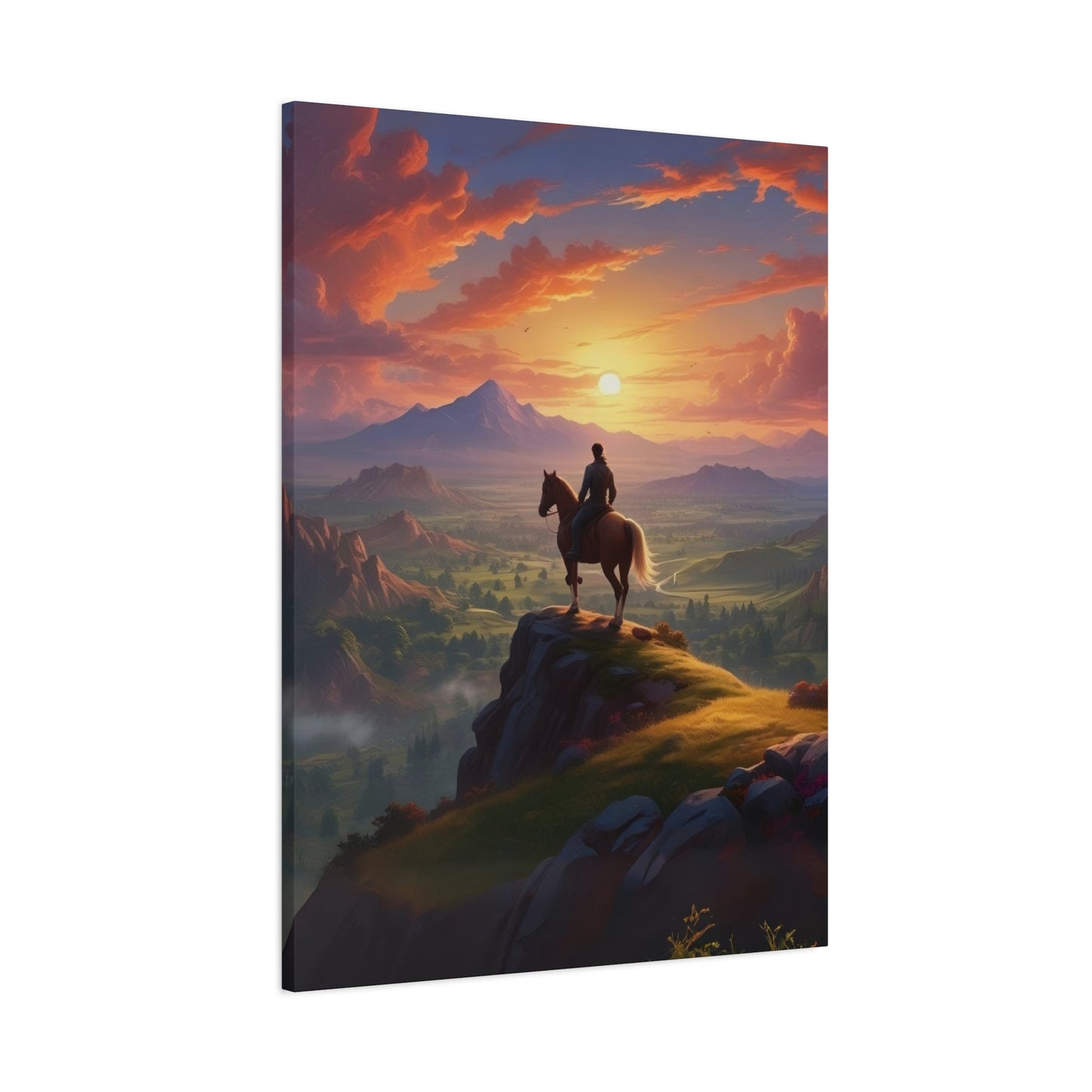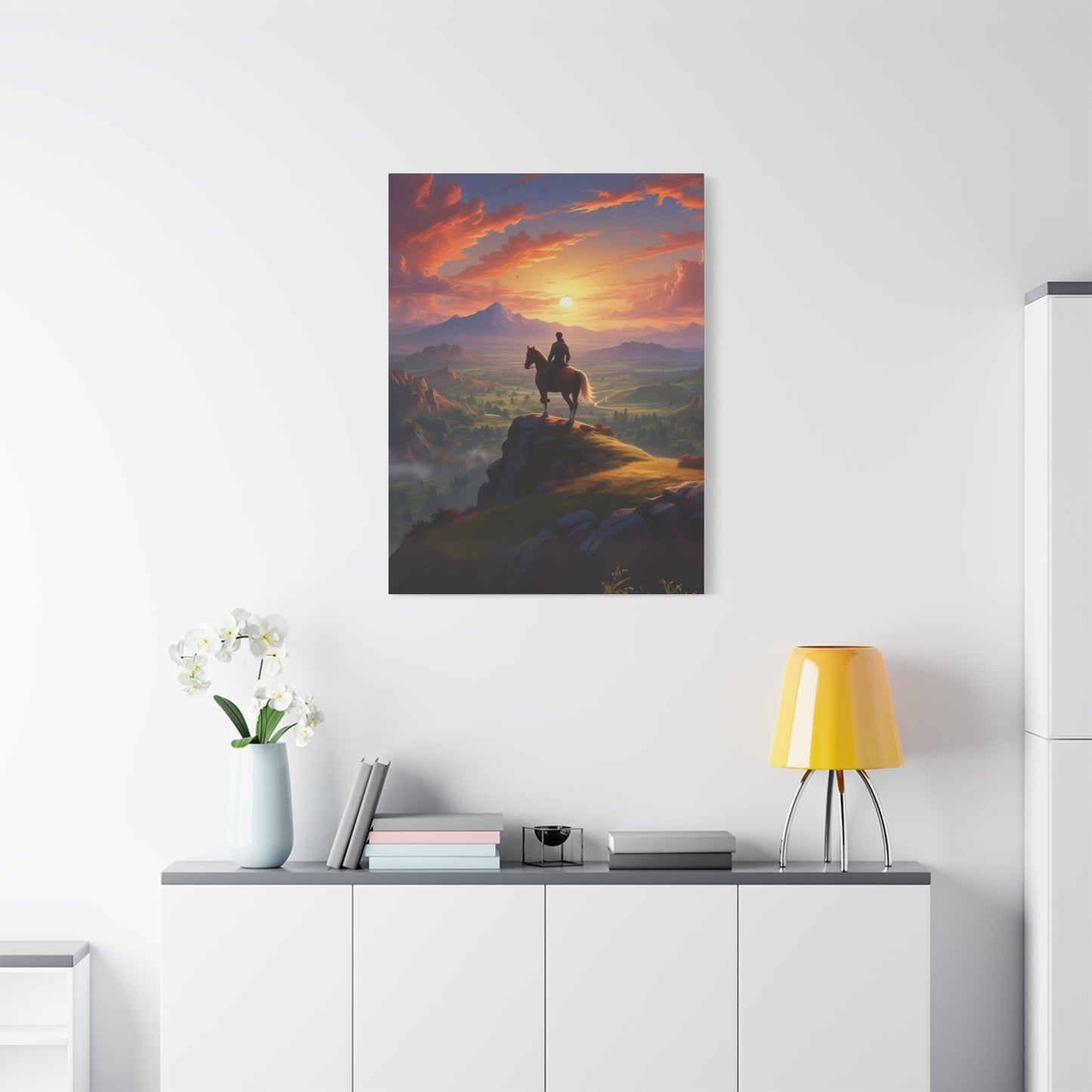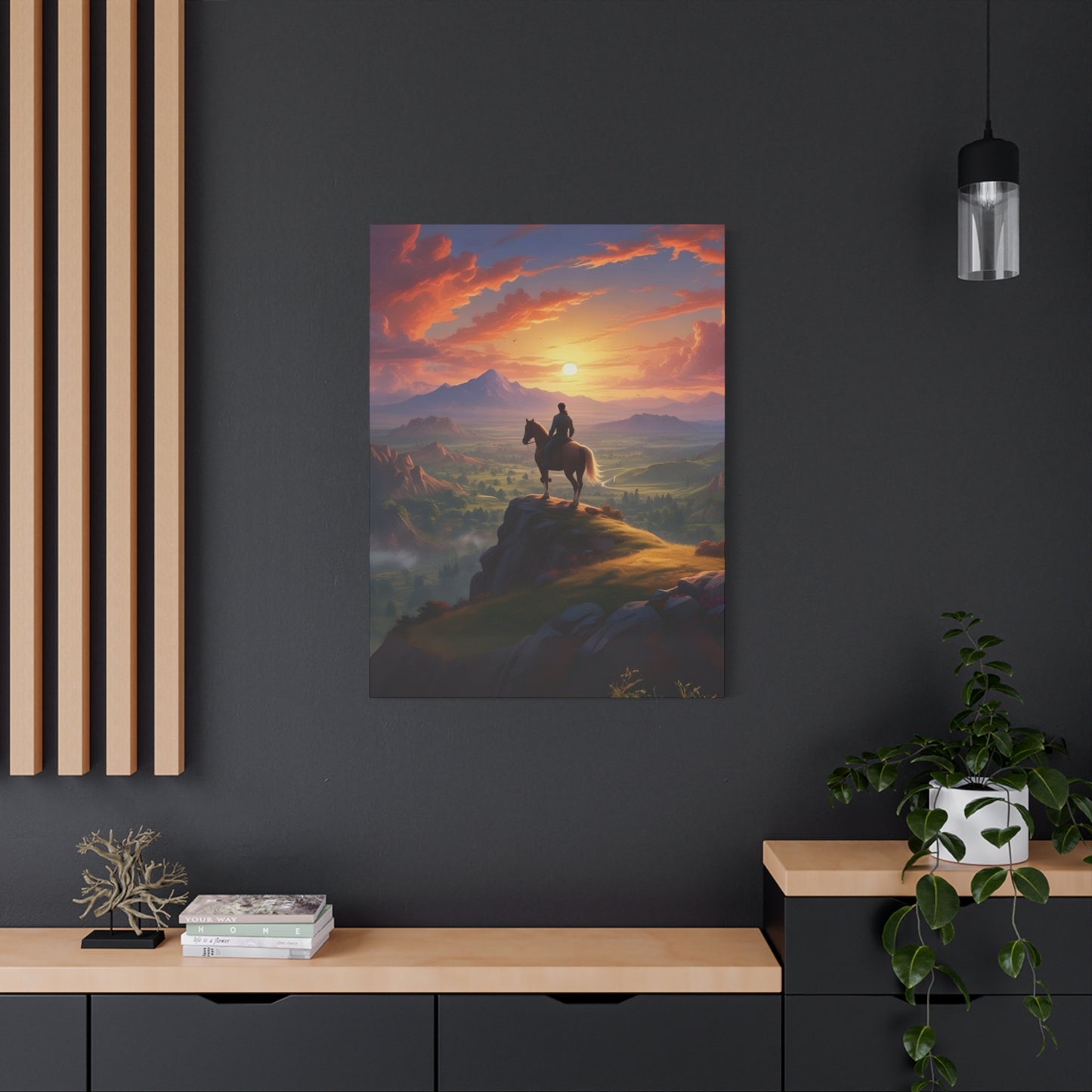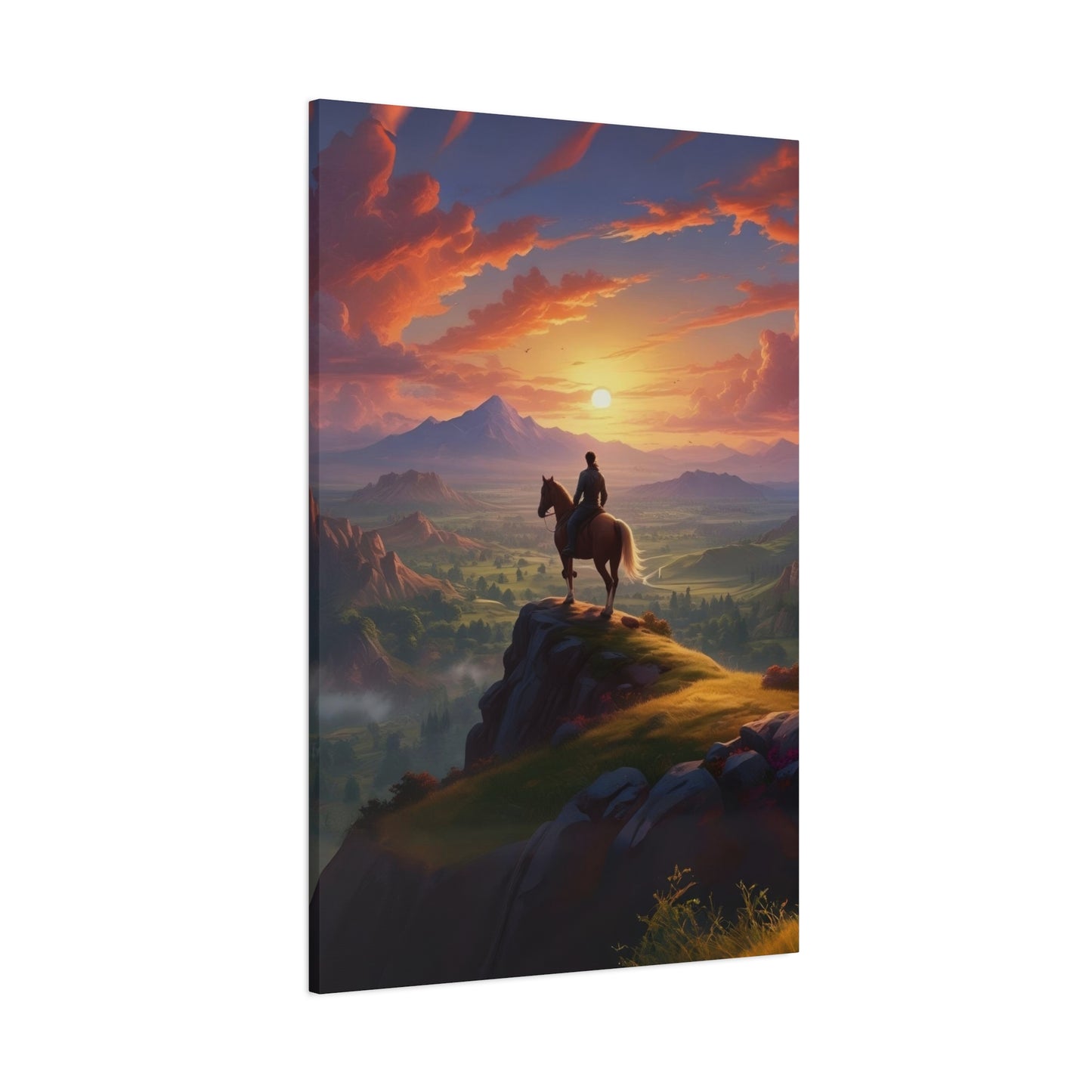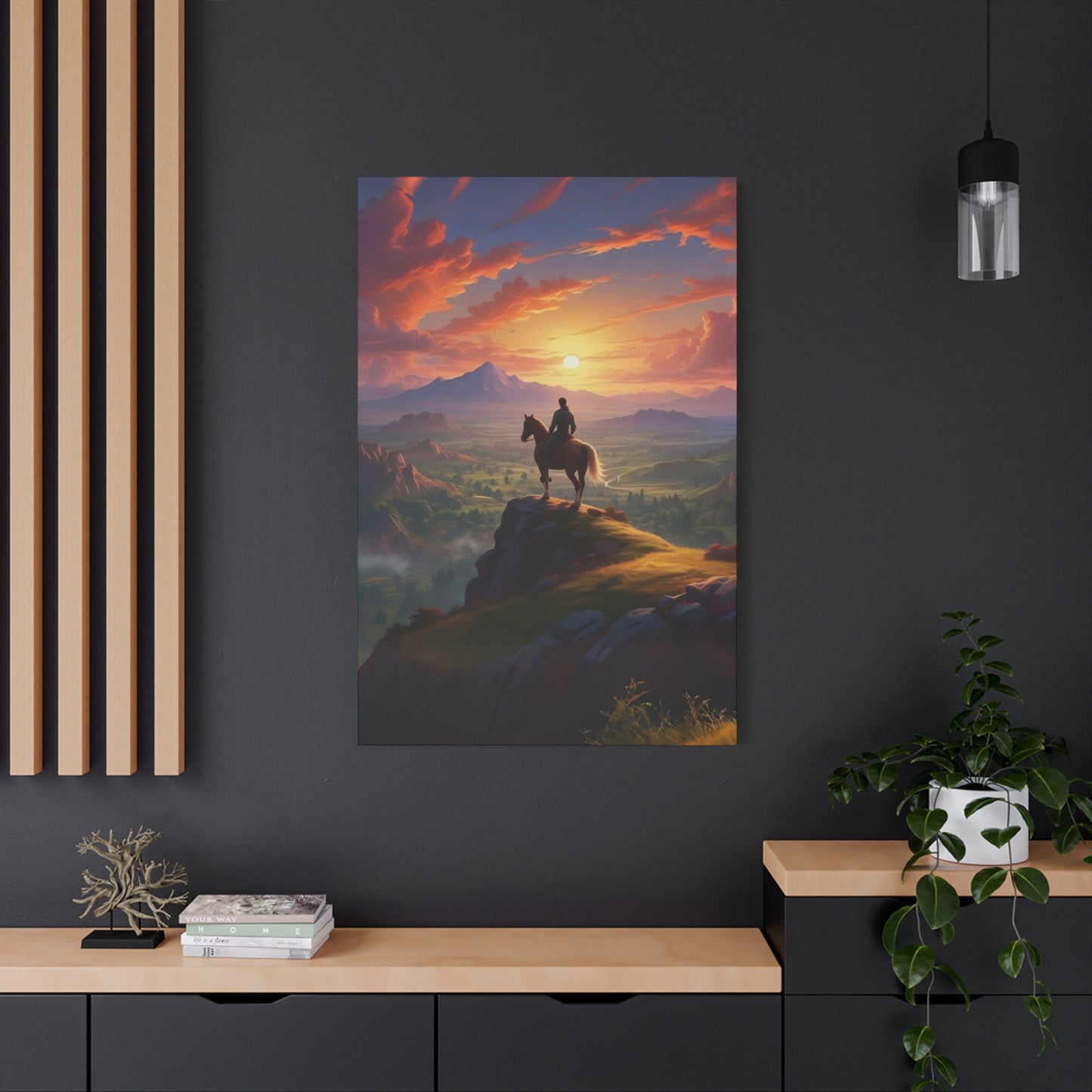Cowboy at Hill Edge Sunset Wall Art: A Journey into the Heart of the West
The allure of the American West has captivated art enthusiasts and interior designers for generations. Among the most evocative representations of this timeless frontier spirit is the imagery of a solitary cowboy positioned at a hill's edge, silhouetted against the breathtaking canvas of a setting sun. This powerful visual narrative combines natural beauty with human presence, creating artwork that speaks to themes of independence, exploration, and the enduring connection between humanity and the untamed landscape. Western-themed canvas prints featuring cowboys at sunset have become increasingly popular in modern interior design, offering homeowners and decorators a way to infuse spaces with rugged charm, historical resonance, and dramatic visual impact. These pieces serve not merely as decorative elements but as conversation starters that transport viewers to wide-open ranges and endless horizons.
The appeal of cowboy sunset imagery extends beyond mere nostalgia. It taps into fundamental human desires for freedom, adventure, and connection with nature. When a lone figure stands against the vastness of a colorful evening sky, the composition creates a powerful balance between solitude and grandeur, between the individual and the infinite. This artistic theme has found its way into countless homes, offices, and commercial spaces, where it brings warmth, character, and a sense of grounded authenticity. The rustic aesthetic associated with Western art complements various interior design styles, from traditional ranch-style homes to contemporary urban apartments seeking a touch of organic texture and earthy color palettes.
Canvas prints featuring cowboys at hill edges during sunset hours offer several advantages as wall decor. The medium itself provides texture and depth that standard paper prints cannot achieve. Canvas stretched over wooden frames creates a three-dimensional quality that enhances the artwork's presence in a room. The fabric surface interacts with light in ways that bring the sunset hues to life, changing subtly as natural and artificial lighting shifts throughout the day. This dynamic quality makes canvas art particularly suitable for capturing the fleeting magic of golden hour, when the sun's rays paint the sky in layers of amber, crimson, coral, and violet.
Majestic Sunset Landscapes with Lone Cowboy
The composition of majestic sunset landscapes featuring a solitary cowboy represents one of the most powerful visual narratives in Western art. These scenes typically position the horseback rider or standing figure at a strategic point within the frame, often following the rule of thirds to create visual harmony while maintaining dramatic tension. The lone cowboy serves as both subject and scale reference, emphasizing the vastness of the natural world that surrounds him. This artistic choice reflects the historical reality of cowboy life, where individuals often spent long hours alone with their thoughts, their horses, and the endless expanse of prairie, desert, or mountain terrain.
The majesty of these landscapes comes from the artist's ability to capture the transitory beauty of sunset. Each evening brings a unique display of atmospheric conditions, cloud formations, and light quality that painters and photographers work to immortalize. In canvas art, these moments are frozen in time, allowing viewers to experience that specific convergence of elements repeatedly. The color gradations in a well-executed sunset scene can range from deep purples and blues in the upper atmosphere to brilliant oranges and reds near the horizon, often with hints of gold and pink threading through cloud banks. These chromatic layers create visual depth that draws the eye into the composition, making even two-dimensional artwork feel expansive and immersive.
The lone cowboy element adds narrative possibility to what might otherwise be a simple landscape. Viewers naturally begin to wonder about the figure's story, his destination, or what thoughts occupy his mind as he pauses to observe the day's end. This storytelling aspect makes the artwork emotionally resonant, transforming it from mere decoration into a meditation on universal themes. The cowboy might be returning home after a long day's work, surveying land he protects, or simply taking a moment to appreciate natural beauty before darkness falls. This ambiguity allows each viewer to project their own interpretations and emotions onto the scene.
From a design perspective, these majestic landscapes work exceptionally well in spaces that benefit from a focal point. Large-format canvas prints can anchor a living room, den, or office, providing a visual center around which other design elements can be arranged. The horizontal orientation common to landscape compositions complements furniture arrangements and architectural features like mantels, console tables, and long walls. The natural color palette of sunset scenes, dominated by warm earth tones and sky blues, coordinates easily with a wide range of interior color schemes, from neutral beiges and grays to richer browns, rusts, and forest greens.
The emotional impact of these scenes cannot be understated. Sunset has long been associated with reflection, closure, and transitions. Combined with the solitary figure, the imagery evokes feelings of peaceful contemplation, resilience, and quiet strength. For many people, these artworks serve as visual reminders to slow down, appreciate beauty, and maintain perspective amid life's busy demands. In office environments, such pieces can provide a mental escape, offering employees a momentary retreat to open spaces and natural wonder. In residential settings, they create atmosphere and establish a room's emotional tone, whether that's relaxed and contemplative or bold and adventurous.
Capturing the Spirit of the Wild West on Canvas
Capturing the authentic spirit of the Wild West on canvas requires more than technical proficiency; it demands an understanding of the cultural, historical, and emotional resonance that this era holds in collective imagination. The Wild West represents a specific period in American history, roughly spanning from the 1860s through the early 1900s, when the frontier was being settled, cattle drives were common, and cowboys became iconic figures in the national narrative. Artists working in this genre must balance historical accuracy with artistic interpretation, creating works that feel authentic while also serving aesthetic and decorative purposes.
The spirit of the Wild West encompasses several key elements that effective canvas art must convey. First is the sense of vast, untamed wilderness. The American West before extensive settlement featured landscapes that stretched beyond the horizon, where human presence was dwarfed by natural features like mountain ranges, canyons, and endless grasslands. Canvas prints that successfully capture this spirit emphasize scale and openness, often using atmospheric perspective to show distance and employing composition techniques that prevent the scene from feeling cluttered or confined. The sky typically occupies significant canvas real estate, reflecting the open-air reality of Western landscapes where cloud formations and weather patterns are visible for miles.
Second is the element of rugged individualism. Cowboys represented self-reliance, hard work, and the ability to endure difficult conditions with minimal complaint. Canvas art that captures this spirit often shows figures engaged in labor or pausing during their work day, depicted with weathered clothing, practical gear, and postures that suggest competence and determination. Even when the cowboy is at rest, as in sunset scenes where he observes the landscape, there's an implied readiness, a sense that this is merely a brief pause before the next task. This quality resonates with contemporary viewers who value independence and perseverance.
Third is the connection between humans and animals, particularly horses. In the cowboy era, horses were not merely transportation but partners, companions, and essential tools for survival. Canvas art that authentically represents Western spirit shows this relationship through body language, positioning, and the care with which both figures are rendered. A cowboy might rest a hand on his horse's neck, or the two might be positioned side by side as equals surveying the landscape together. This partnership aspect adds emotional depth and speaks to themes of loyalty, trust, and mutual dependence that transcend the specific historical context.
The color palette used in authentic Western canvas art plays a crucial role in conveying period and place. Earth tones predominate, reflecting the natural colors of prairie grass, desert sand, rocky outcroppings, and clay soil. Leather browns, worn denim blues, sun-bleached fabrics, and the varied greens of scrub vegetation all contribute to a palette that feels grounded and organic. Sunset scenes expand this palette dramatically, introducing warm hues that feel like natural extensions of the earth-toned landscape rather than artificial insertions. The reds, oranges, and golds of sunset can echo the colors of canyon walls, autumn grasses, and campfire light, creating thematic coherence.
Canvas as a medium particularly suits Western themes because of its texture and presence. Unlike smooth paper prints or glossy photographs, canvas has a tactile quality that complements rustic subject matter. The visible weave of the fabric adds subtle texture that can enhance the illusion of brush strokes and paint application, even in reproductions of original artwork. When stretched over substantial wooden frames, canvas prints gain a dimensional quality that makes them feel more like original paintings than reproductions, adding perceived value and authenticity to the piece.
Cowboy Silhouettes Against Vibrant Evening Skies
The artistic technique of rendering cowboy figures as silhouettes against vibrant evening skies represents one of the most visually striking approaches to Western canvas art. This method simplifies the foreground elements to dark shapes while allowing the background sky to explode with color and detail, creating maximum contrast and dramatic impact. Silhouette compositions have a long history in art, dating back centuries, but their application to Western themes creates particularly powerful results. The technique works on multiple levels simultaneously, offering aesthetic beauty, narrative suggestion, and practical decorative advantages.
From a purely visual standpoint, silhouette compositions create immediate graphic impact. The stark contrast between the dark foreground figure and the luminous sky behind it draws the eye and holds attention. Unlike more complex renderings where the viewer's eye might wander across multiple detailed areas, silhouette compositions provide clear visual hierarchy. The sky becomes the stage, and the cowboy becomes the protagonist, backlit and mysterious. This clarity makes silhouette artwork particularly effective in spaces where the art needs to make an impression quickly, such as entryways, waiting rooms, or any area where people spend brief periods.
The vibrant evening skies in these compositions carry much of the emotional and aesthetic weight. Sunset and twilight offer artists the richest color palettes available in nature, with gradations and combinations rarely seen at other times of day. A skilled artist might layer deep purples and blues in the upper regions of the sky, transitioning through violets and magentas in the middle zones, then exploding into brilliant oranges, reds, and golds near the horizon. Cloud formations, when present, add additional complexity, catching light on their undersides while remaining darker above, creating three-dimensional forms within the two-dimensional image. These chromatic displays provide the warmth and energy that make the artwork inviting and engaging.
The silhouette technique also serves practical purposes in interior design. Because the cowboy figure is rendered as a solid dark shape without internal detail, it reads clearly from any distance and under various lighting conditions. This makes silhouette artwork ideal for spaces with challenging lighting, such as rooms with windows that create glare or areas illuminated primarily by artificial light. The simplified foreground also means the artwork won't compete visually with other design elements in the room. The colors in the sky can coordinate with room colors, but the dark silhouette provides neutral grounding that anchors the composition.
Narrative and emotional dimensions of silhouette compositions are particularly intriguing. By obscuring the cowboy's facial features and fine details, the artist creates a figure that becomes everyman rather than a specific individual. Viewers can more easily project themselves into the scene, imagining their own thoughts and feelings in that moment of sunset observation. The mystery created by the silhouette invites contemplation rather than providing answers. What expression does the cowboy wear? Is he smiling, serious, weary, or content? The absence of these details allows each viewer to complete the narrative according to their own interpretation and mood.
The positioning of silhouetted figures within the composition requires careful consideration. Placed too centrally, the figure might create a static, overly symmetrical image. Positioned according to compositional principles like the rule of thirds or golden ratio, the silhouette creates dynamic balance while leaving room for the sky to breathe and expand. The cowboy might be placed in the lower third of the canvas, looking toward the brighter portion of the sky, creating a sense of directionality and purpose. Alternatively, positioning the figure along one side edge can emphasize the vastness of the landscape and sky, making the human presence seem even more solitary and small against nature's grandeur.
Sunset-Inspired Wall Art for Western-Themed Interiors
Incorporating sunset-inspired wall art into Western-themed interiors requires thoughtful consideration of how the artwork will interact with existing design elements while enhancing the room's overall aesthetic and atmosphere. Western-themed interiors can range from traditional ranch-style spaces featuring rough-hewn wood, leather furniture, and vintage ranch implements to more contemporary interpretations that blend rustic elements with modern design principles. Sunset canvas art bridges these various approaches, offering flexibility while maintaining thematic coherence.
The color palette of sunset artwork naturally complements the warm earth tones typical of Western interior design. Leather furniture in shades of tan, caramel, and cognac echoes the warm oranges and golds in sunset skies. Wooden elements, whether flooring, ceiling beams, or furniture pieces, share tonal qualities with the earthy foreground elements in landscape compositions. Stone features like fireplaces or accent walls coordinate with the geological colors often present in Western sunset scenes, where rock formations might catch the last light of day. This natural color harmony means sunset canvas art integrates seamlessly without requiring dramatic adjustments to existing color schemes.
Scale considerations are paramount when selecting canvas art for Western-themed spaces. Many Western interiors feature generous proportions, with high ceilings, large windows, and substantial furniture pieces. Artwork must be sized appropriately to hold its own in these spaces without being overwhelmed. A large-format canvas, perhaps 48 by 72 inches or even larger, can serve as a commanding focal point above a fireplace mantel or sofa. Medium-sized pieces, in the 30 by 40 inch range, work well in bedroom settings or smaller gathering areas. Gallery walls featuring multiple coordinating sunset scenes can fill expansive wall spaces while creating visual interest through variety and repetition.
Placement of sunset canvas art should consider both aesthetic and practical factors. In living areas, positioning artwork at eye level when seated allows comfortable viewing during relaxation. Above a sofa, the canvas should be centered with the furniture grouping, typically leaving 6 to 12 inches between the sofa back and the bottom of the frame. In dining areas, sunset art can create a warm, inviting atmosphere that enhances the communal aspects of shared meals. Bedrooms benefit from calming sunset scenes positioned where they're visible from the bed, providing a peaceful view before sleep and upon waking.
Lighting plays a crucial role in showcasing sunset canvas art effectively. While the artwork depicts a light source, it also requires proper illumination to display its colors and details optimally. Track lighting with adjustable heads can be angled to highlight the canvas without creating glare. Picture lights mounted directly above the frame provide focused illumination that makes colors glow. In rooms with abundant natural light, consider how window placement affects the artwork throughout the day. Morning sun might create glare, while afternoon and evening light can enhance the warm tones in the sunset imagery, creating almost magical moments when natural and depicted light sources seem to interact.
Framing choices impact how sunset canvas art integrates with Western-themed interiors. Gallery-wrapped canvas, where the image continues around the edges of the stretcher bars, offers a contemporary, clean look that works well in modern Western spaces. Traditional frames in dark woods like walnut or espresso create a more formal presentation suitable for traditional ranch homes or spaces with classic Western styling. Lighter wood frames in natural or weathered finishes provide rustic charm without heaviness. Some designers opt for no visible frame at all, allowing the raw canvas edges to show for a casual, studio-like appearance that emphasizes the artwork's handcrafted quality.
Rustic Charm and Dramatic Skies in Canvas Prints
The combination of rustic charm and dramatic skies in canvas prints creates artwork that satisfies both aesthetic and emotional desires. Rustic charm speaks to authenticity, simplicity, and connection with natural materials and traditional ways of life. Dramatic skies provide grandeur, visual excitement, and a sense of nature's power and beauty. Together, these elements create balanced compositions that feel grounded yet aspirational, familiar yet awe-inspiring. This duality makes such artwork particularly versatile and appealing across diverse settings and viewer preferences.
Rustic charm manifests in canvas art through several visual strategies. Weathered textures, whether in the depiction of wooden fence posts, worn saddle leather, or rough stone outcroppings, communicate age, use, and history. These elements tell stories of endurance and utility rather than pristine newness. Colors associated with rustic aesthetics tend toward muted, natural tones that look as though they've been sun-bleached or dust-covered. There's an honesty to these palettes that viewers find comforting and authentic. Rustic compositions often include man-made elements like barns, windmills, or corrals, showing how humans have adapted to and worked within natural environments rather than dominating them.
Dramatic skies contrast with this groundedness by introducing elements of spectacle and change. Storm clouds gathering on the horizon, shafts of light breaking through overcast conditions, or the brilliant color displays of sunset and sunrise all represent nature's theatrical side. These atmospheric conditions are temporary and precious, occurring only when specific meteorological factors align. Capturing them in canvas art preserves these fleeting moments, allowing viewers to experience their drama repeatedly. The sky portion of these compositions often occupies fifty percent or more of the canvas, giving it appropriate prominence and allowing the dramatic elements room to develop across the picture plane.
The interplay between rustic foreground elements and dramatic skies creates visual tension that keeps artwork engaging. The eye moves between the detailed, textured, earthbound elements and the fluid, changeable, ethereal sky above. This movement prevents the composition from becoming static. A weathered fence might lead the eye toward the horizon, where storm clouds gather. A solitary tree bent by prevailing winds points toward a gap in the clouds where light pours through. These compositional devices create pathways through the image that guide viewing while allowing exploration.
Technical execution of both rustic and dramatic elements requires different approaches. Rustic textures benefit from detailed rendering, close value relationships, and careful attention to the way light reveals surface qualities. Dramatic skies need bold color decisions, confident brushwork or photographic technique, and understanding of atmospheric effects like light scattering and cloud formation. Artists who successfully combine these elements demonstrate versatility and range, showing they can handle both intimate detail and grand gesture within a single composition.
The emotional impact of combining rustic charm with dramatic skies speaks to fundamental human experiences. The rustic elements represent stability, tradition, and human perseverance. The dramatic skies symbolize forces beyond human control, the sublime aspects of nature, and the constant changes that characterize existence. Together, they suggest themes of resilience in the face of challenge, finding beauty in both the humble and the magnificent, and maintaining equilibrium between groundedness and aspiration. These themes resonate across demographic groups and personal philosophies, contributing to the broad appeal of this artistic approach.
From an interior design perspective, canvas prints featuring rustic charm and dramatic skies offer exceptional versatility. They work equally well in traditional Western settings and in more eclectic spaces seeking to introduce organic, natural elements. The rustic aspects prevent the artwork from feeling too formal or precious, while the dramatic skies elevate it beyond mere decoration. This balance allows the artwork to function in various contexts, from casual family rooms to more formal entertaining spaces, from residential settings to commercial environments like restaurants, hotels, or corporate offices seeking to create welcoming atmospheres.
Cowboy at Hill Edge: Bold Statement Wall Décor
Positioning a canvas print featuring a cowboy at a hill edge as bold statement wall décor requires confidence in both the artwork selection and its placement. Statement pieces serve as visual anchors that establish a room's character, set its emotional tone, and provide a focal point around which other design decisions orbit. When this statement piece depicts a cowboy surveying the landscape from an elevated vantage point, it introduces themes of vision, perspective, and contemplation that resonate on both aesthetic and philosophical levels.
The hill edge positioning creates inherent drama through several compositional factors. Vertical elevation naturally suggests achievement, aspiration, and expanded perspective. The figure at the hilltop has literally risen above the surrounding terrain, metaphorically suggesting rising above challenges or gaining broader vision. This positioning also creates depth in the composition, as the elevated viewpoint allows the artist to show layers of landscape receding into the distance. The immediate hillside might be rendered in sharp detail, middle-distance features shown with moderate detail, and far horizons treated with atmospheric softening. This layering creates spatial recession that makes two-dimensional artwork feel three-dimensional and immersive.
The boldness of such statement pieces comes not only from content but from scale and presentation. Large-format canvases, particularly those exceeding four feet in any dimension, command attention simply through size. They cannot be overlooked or dismissed as minor decorative touches. When the subject matter carries as much visual and thematic weight as a cowboy against sunset at a hill edge, the combination of substantial size and powerful imagery creates undeniable impact. This is artwork that announces itself, that shapes the room's identity rather than merely filling wall space.
Color intensity contributes significantly to the statement-making quality. Bold artwork doesn't necessarily mean loud or garish; it means confident color decisions executed with conviction. A sunset rendered in rich, saturated hues rather than pale, tentative tones demonstrates artistic boldness. Deep oranges that verge on red, purples so intense they approach violet, and golds that shimmer with warmth all contribute to visual confidence. These colors need adequate canvas real estate to develop and display their intensity, another reason why statement pieces tend toward larger formats.
Evoking Adventure and Freedom Through Canvas Art
Canvas art featuring Western themes, particularly scenes of cowboys in expansive landscapes, excels at evoking feelings of adventure and freedom. These emotional responses aren't accidental but rather result from deliberate compositional choices, subject matter selection, and the psychological associations viewers bring to the imagery. Understanding how visual elements trigger these feelings helps in both creating and selecting artwork that successfully delivers desired emotional impact.
Adventure implies possibility, risk, discovery, and breaking from routine. Canvas art communicates adventure through several visual strategies. Open landscapes stretching to distant horizons suggest unexplored territory and unknown possibilities. A cowboy positioned as if in motion, whether riding, walking, or standing in a posture that suggests imminent movement, implies journey rather than stasis. The inclusion of paths, trails, or open range invites the viewer's eye to travel through the composition, creating a sense of going somewhere rather than being fixed in place. Even static scenes can suggest adventure through atmospheric elements like gathering clouds or changing light that indicate the passage of time and shifting conditions.
Freedom manifests in artwork through representations of space, independence, and lack of constraint. Wide-open landscapes without fences, roads, or signs of settlement communicate freedom from physical boundaries. The solitary figure represents freedom from social constraint, the ability to make independent decisions without committee or consensus. The cowboy's traditional role as someone who works alone or in small groups, largely self-directed and self-reliant, reinforces themes of personal autonomy. Sky occupying substantial canvas area suggests freedom from enclosure, the ability to breathe, expand, and exist without ceiling or limit.
Color psychology plays a role in evoking these feelings. Warm colors like oranges and reds stimulate excitement and energy, supporting feelings of adventure. Blues and purples in sky gradations suggest depth and possibility, the vastness of space and potential. Earth tones ground these more energetic colors, preventing the composition from feeling chaotic while still maintaining emotional warmth. The balance between stimulating and calming colors creates artwork that feels energizing without being overwhelming, inviting without being demanding.
Layered Textures and Warm Sunset Hues
The artistic treatment of layered textures combined with warm sunset hues creates canvas art with particular depth and visual richness. Texture in two-dimensional artwork can be actual, meaning physical variations in the surface, or implied, meaning visual representations that suggest texture without three-dimensional presence. Both approaches add complexity and interest that flat, uniform surfaces lack. When these textural elements combine with the inherently appealing warm colors of sunset, the result is artwork that invites prolonged viewing and emotional engagement.
Physical texture in canvas prints can result from several sources. Original paintings naturally include brushstroke texture, with paint building up in some areas and lying thin in others, creating actual three-dimensional variation across the canvas surface. Palette knife techniques can create even more pronounced texture, with thick paint application that casts shadows and catches light. Even high-quality prints on canvas can simulate some texture through specialized printing techniques that layer ink to create subtle relief. Gallery-wrapped canvas stretched over wooden bars introduces edge texture where the fabric wraps around the frame. These physical textures interact with light in ways that make the artwork change appearance as lighting conditions shift throughout the day.
Implied texture relies on visual tricks to suggest surface qualities without actual dimensional variation. An artist might paint rough stone with careful attention to highlights and shadows that make the eye perceive roughness even though the canvas remains smooth. Wood grain, weathered leather, dried grass, and fabric weaves can all be rendered with sufficient skill to fool the eye into sensing texture that isn't literally present. This implied texture adds visual interest and contributes to the overall realism or stylization of the piece, depending on how naturalistically it's executed.
Layering in canvas compositions creates spatial depth and visual complexity. In landscape paintings featuring sunset, layers might include the immediate foreground with detailed ground cover or rocks, a middle ground with the hill edge and cowboy figure, and multiple background layers showing successive ridges, valleys, or mountain ranges fading into atmospheric distance. Each layer might receive different textural treatment, with foreground elements most detailed and textured, and distant elements increasingly simplified and softened. This layering mimics how the human eye actually perceives depth, making the artwork feel more realistic and immersive.
Rustic Western Canvas Prints for Living Rooms
Living rooms serve as the social hub of most homes, where families gather for relaxation and guests are entertained. The artwork chosen for these spaces significantly influences the room's atmosphere, aesthetic identity, and emotional tone. Rustic Western canvas prints offer particular advantages in living room settings, combining aesthetic appeal with thematic richness and practical decorative benefits. These pieces create focal points that anchor furniture arrangements, introduce color palettes that coordinate with various design elements, and establish the room's character in ways that reflect homeowner personality and values.
The scale requirements for living room artwork differ from other spaces due to typically larger wall expanses and more substantial furniture pieces. A standard sofa measures between 7 and 8 feet in length, and artwork positioned above it should be proportionally sized to balance this mass. A single large canvas, perhaps 60 by 40 inches or larger, can make an appropriate statement above a sofa without being overwhelmed by the furniture below. Alternatively, a horizontal triptych of related Western scenes can span similar width while creating visual interest through variation and repetition. The key is ensuring the artwork relates proportionally to the furniture it accompanies rather than appearing as a small afterthought on a large wall.
Rustic Western canvas prints introduce warmth through both subject matter and color palette. Images of cowboys, ranch scenes, open prairies, and sunset landscapes inherently feel welcoming and down-to-earth rather than formal or intimidating. These themes create conversation-friendly environments where guests feel comfortable and relaxed. The warm earth tones, golden sunset hues, and rich browns typical of this genre create psychological warmth that makes living spaces feel cozy and inviting even in physically large rooms. This emotional warmth proves especially valuable in homes in cooler climates or those with abundant hard surfaces like tile or stone that might otherwise feel cold.
The rustic aesthetic expressed in Western canvas prints coordinates naturally with popular living room furnishings. Leather sofas and chairs, whether in traditional brown tones or more contemporary colors, share the organic quality of Western artwork. Wood coffee tables, entertainment centers, and side tables echo the natural materials and earth tones in the canvas prints. Even contemporary furniture in neutral fabrics gains warmth and character when paired with rustic Western art that prevents the space from feeling too minimal or sterile. The artwork bridges various style periods, allowing antique pieces to coexist harmoniously with modern elements.
Color coordination between rustic Western canvas prints and living room design schemes occurs almost organically. If the room features a neutral base of beiges, tans, and creams, the artwork can introduce richer accent colors through sunset skies or foreground details. If the space already incorporates colorful elements like throw pillows, blankets, or rugs in reds, oranges, or blues, Western artwork featuring similar hues in its sky or landscape elements creates visual cohesion. The natural origin of colors in landscape artwork makes them feel authentic rather than arbitrary, allowing bolder color choices to feel appropriate and integrated.
Cowboy at Hill Edge: Minimalist Western Wall Art
Minimalist artistic approaches might seem contradictory to Western themes traditionally associated with detailed landscapes and narrative richness, yet the combination creates surprisingly effective wall art. Minimalist Western canvas prints, particularly those featuring a cowboy at a hill edge, strip away extraneous details to focus on essential elements: form, color, and negative space. This reductive approach creates artwork that delivers Western character while maintaining the clean, uncluttered aesthetic valued in contemporary design. The result bridges traditional subject matter and modern sensibility, appealing to those who appreciate both.
The minimalist approach to cowboy imagery typically reduces the figure to essential recognizable elements. Rather than detailed rendering of facial features, clothing textures, or equipment, the minimalist cowboy might be suggested through a few carefully placed shapes: the curve of a hat brim, the angle of shoulders, the stance of legs. Color fields replace gradual transitions, with perhaps three to five distinct values creating the figure rather than dozens. This simplification increases rather than decreases the impact, as the viewer's eye isn't distracted by detail and can grasp the composition immediately. The cowboy becomes an icon rather than a portrait, universally recognizable rather than specifically individual.
Background treatment in minimalist Western art embraces negative space and color blocking. Rather than rendering every bush, rock, and cloud, the artist might divide the canvas into horizontal bands of color representing sky, distant hills, and foreground ground plane. These simplified forms maintain landscape recognition while creating compositions with graphic strength. The hill edge becomes a single curved or angular line dividing compositional zones. Sunset might be represented by two or three color bands in the sky rather than complex gradations. This restraint creates visual calm and allows the few included elements to achieve maximum impact.
Color palettes in minimalist Western canvas prints tend toward limitation and intentionality. Rather than attempting to capture every hue visible in a natural sunset, the artist might select three complementary colors that suggest sunset without literally depicting it. Perhaps a deep blue-gray for the silhouetted hill and cowboy, a warm orange for the horizon band, and a pale yellow-pink for the upper sky. These limited palettes create sophisticated color relationships and demonstrate artistic confidence in color selection. The restraint also makes the artwork easier to integrate with various interior color schemes since there are fewer colors to coordinate.
Timeless Western Landscapes Captured on Canvas
The concept of timelessness in Western landscape art refers to imagery that transcends specific historical moments to communicate universal experiences and emotions that resonate across generations. Timeless Western landscapes avoid overly specific contemporary elements that would date the artwork, instead focusing on natural features and archetypal human-nature relationships that remain relevant regardless of current trends. Canvas prints featuring these timeless qualities become long-term investments in home décor rather than trendy pieces that quickly feel outdated.
Natural landscape features provide the foundation for timeless Western imagery. Mountain ranges, canyons, prairies, deserts, and sky all existed long before human observation and will continue after. These geological and atmospheric elements connect viewers to deep time and natural cycles that dwarf individual human lifespans. An artist depicting these features creates work that would be recognizable and meaningful to viewers a century ago and will remain so for viewers a century hence. The shapes, colors, and scale relationships of these natural elements tap into aesthetic responses that appear hardwired in human perception rather than culturally contingent.
The inclusion of human figures in timeless Western landscapes requires careful consideration. Specific clothing styles, technologies, or activities can date artwork to particular decades. However, certain universal postures and activities transcend time: standing and observing, riding horseback, working with animals, pausing for rest. When these activities are rendered without excessive detail on contemporary gear or fashion, they become archetypal rather than historically specific. The cowboy becomes representative of human relationship with land and livestock rather than a specific period costume character. This careful balance allows human presence without sacrificing timeless quality.
Seasonal ambiguity contributes to timeless appeal. While some Western landscapes clearly depict specific seasons, others maintain a certain temporal ambiguity that could represent multiple times of year. Bare ground might be early spring or late fall. Golden grasses could be summer-dry or autumn-changing. This ambiguity allows viewers to project their own seasonal associations and memories onto the artwork, personalizing it through interpretation. Year-round appropriateness also results, as the artwork never feels seasonally mismatched with current conditions outside the window.
Cowboy Silhouettes and Dramatic Skies for Bedrooms
Bedroom artwork serves different purposes than pieces displayed in social spaces, primarily influencing the room's occupants rather than impressing guests. Canvas prints featuring cowboy silhouettes against dramatic skies offer particular advantages in bedroom settings, where their combination of visual interest and emotional tone creates environments conducive to relaxation, reflection, and restoration. The private nature of bedrooms allows for more personal artistic choices that resonate with individual preferences without concern for broad appeal.
The silhouette treatment of cowboy figures provides ideal visual characteristics for bedroom art. Unlike highly detailed portraits or scenes that might feel busy or stimulating, silhouettes offer simplified forms that the eye can take in without effort. This visual simplicity reduces mental stimulation, supporting the bedroom's primary function as a space for rest and sleep. The recognizable cowboy form provides interest and character without demanding attention or analysis. Viewers can engage with the imagery when desired but can equally allow it to recede into comfortable background presence during daily routines.
Dramatic skies in bedroom canvas prints must balance visual excitement with color choices appropriate for rest spaces. While vibrant sunset oranges and reds create energy and warmth, they might feel too stimulating in bedrooms where calming influences are preferred. Many successful bedroom pieces feature skies transitioning from warm tones near the horizon to cooler blues and purples in upper portions, providing visual drama while introducing calming cool colors. Twilight and dusk scenes, with their softer light and more subtle color transitions, often work particularly well in bedroom settings, supporting the transition from activity to rest that bedrooms facilitate.
Placement of cowboy silhouette canvas prints in bedrooms requires consideration of viewing angles and times. The most common viewing position is from the bed, either while reclining or sitting. Artwork positioned on the wall opposite the foot of the bed provides an immediate view upon waking and a focal point visible during evening reading or conversation. Alternatively, placement on the wall behind the headboard creates ambiance visible upon entering the room and can be glimpsed from other positions while maintaining the wall opposite the bed clear for other purposes like a television or window views.
Scale in bedroom canvas art tends toward moderate rather than monumental. While living rooms can accommodate and often benefit from very large pieces, bedrooms feel more intimate and personal, and artwork should be sized accordingly. A canvas measuring 30 by 40 inches or 36 by 48 inches provides substantial presence without overwhelming the space. In larger master bedrooms, slightly larger pieces work well, while guest bedrooms and children's rooms might be better served by more modest sizes. The goal is creating impact proportional to the room's scale and function.
Spaces with Sunset-Inspired Canvas Prints
The integration of sunset-inspired canvas prints into diverse interior spaces requires understanding how these pieces interact with architectural features, natural lighting, and functional requirements specific to each room type. While cowboy sunset imagery works beautifully in traditional settings like living rooms and bedrooms, its versatility allows successful application in unexpected spaces including home offices, dining areas, entryways, and even bathrooms. The key lies in recognizing how the artwork's specific characteristics align with each space's unique demands and opportunities.
Home offices benefit significantly from sunset canvas prints that provide visual relief during long work periods. The warm colors energize without overstimulating, supporting focus and creativity. A canvas positioned within easy view from the desk offers a momentary escape during mental breaks, allowing the eyes and mind to rest on peaceful imagery before returning to work tasks. The independence and self-reliance associated with cowboy imagery can serve as subtle inspiration for entrepreneurs, remote workers, or anyone whose work requires autonomous decision-making and self-motivation. The dramatic sky element reminds office occupants that beauty and natural wonder exist beyond spreadsheets and email, supporting work-life balance in spaces where professional and personal realms overlap.
Dining rooms transform through sunset canvas art that enhances the communal and ceremonial aspects of shared meals. The warm colors create appetite appeal and contribute to convivial atmospheres where conversation flows. Positioning sunset artwork where it's visible from the dining table gives family members and guests something beautiful to contemplate during meals, elevating even ordinary dinners into more special occasions. The dramatic quality of sunset skies adds a touch of occasion and festivity appropriate for spaces dedicated to gathering and celebration. In formal dining rooms used primarily for special meals, the artwork contributes to the sense of these spaces being set apart from everyday living areas.
Entryways and foyers create first impressions that sunset cowboy canvas prints can shape powerfully. A substantial piece immediately visible upon entering establishes the home's character as one that values natural beauty, Western heritage, and boldness. The artwork becomes a greeting to visitors and a welcome home to residents, creating a transitional moment between outside world and personal sanctuary. In two-story foyers with significant wall height, large-format sunset canvases fill vertical space impressively while maintaining horizontal landscape orientation that prevents awkward proportions. The warm colors in sunset imagery create psychological warmth that makes entries feel welcoming rather than cold or formal.
Bold Colors and Natural Beauty in Cowboy Art
The intersection of bold color choices and natural beauty representations creates Western canvas art with particular visual power and emotional resonance. Bold colors command attention, create energy, and establish mood, while natural beauty provides authenticity, timelessness, and connection to viewers' experiences and memories of outdoor environments. When these qualities combine in cowboy sunset imagery, the result is artwork that satisfies both immediate aesthetic impact and deeper contemplative engagement.
Bold color application in Western art often centers on sunset and sunrise skies, where nature itself provides justification for intense hues. A sky rendered in saturated oranges, deep purples, and brilliant reds doesn't read as artificial or exaggerated when viewers recognize these as natural phenomena they've witnessed themselves. This grounding in observable reality allows artists to push color intensity without losing credibility. The boldness enhances rather than contradicts the natural beauty, amplifying the emotional impact of atmospheric conditions that actually occur but are rarely captured in ordinary experience due to their brief duration and dependence on specific conditions.
Color temperature contrasts create particular drama in bold Western canvas art. The warm colors of sunset, advancing visually and psychologically, contrast with cool colors in shadows, distant mountains, or early evening sky portions, which recede. This temperature contrast creates spatial depth through color relationships alone, separate from perspective or scale cues. A dark blue-purple hill silhouette against an orange-red sky creates maximum temperature contrast, causing the elements to vibrate visually and command attention. These bold contrasts require confident handling to avoid garishness, but when executed successfully, they create memorable and powerful imagery.
Saturation decisions affect how bold colors appear and function. Fully saturated hues at maximum intensity create vibrant, energetic artwork that dominates spaces and demands attention. Slightly desaturated versions of the same hues maintain visual interest while feeling more sophisticated and easier to live with in residential settings. The artist's choice of saturation level should consider the artwork's intended environment and purpose. Commercial spaces might warrant maximum boldness for impact, while private homes might prefer slightly moderated versions that won't feel overwhelming during daily living.
Conclusion:
Cowboy at Hill Edge Sunset Wall Art: A Journey into the Heart of the West captures the essence of western landscapes and the timeless allure of frontier life, offering homeowners a way to bring the rugged beauty and introspective spirit of the American West into their living spaces. This style of wall art, featuring a lone cowboy poised at the edge of a hill against the backdrop of a glowing sunset, combines dramatic scenery, human narrative, and emotive color palettes to create interiors that are both visually captivating and emotionally resonant. These pieces serve as more than mere decoration—they tell stories, evoke moods, and connect viewers to the enduring spirit of adventure, resilience, and freedom associated with the West.
The appeal of hill edge sunset cowboy art lies in its evocative storytelling. The lone figure, often silhouetted against vast skies painted in rich oranges, purples, and golds, invites contemplation and introspection. Viewers are drawn into the scene, imagining themselves at the precipice alongside the cowboy, witnessing the unfolding panorama of mountains, valleys, and fading light. This sense of scale and perspective fosters a connection to nature, emphasizing both its grandeur and the quiet introspection it inspires. Such artworks transform living spaces into narrative environments, where walls become stages for imagination and emotional engagement.
From an interior design perspective, cowboy hill edge sunset wall art is versatile and adaptable. In rustic, southwestern, or farmhouse-style interiors, these canvases enhance authenticity and thematic cohesion, harmonizing with natural textures like wood, leather, and stone. In contemporary or minimalist spaces, the artwork acts as a striking focal point, introducing drama, warmth, and narrative depth without overpowering the room. Strategic placement, scale, and framing are critical; a large canvas over a mantel, sofa, or bed commands attention and creates a cinematic effect, while smaller or grouped prints allow for gallery-style storytelling, offering layered visual interest throughout a space.
Color and light are central to the artwork’s impact. Sunset hues—warm golds, deep ambers, fiery reds, and subtle purples—evoke both the serenity and drama of the western landscape. The interplay of light and shadow emphasizes depth, texture, and form, while the silhouette of the cowboy provides contrast and focus. This dynamic combination of tonal richness and compositional precision enhances the room’s ambiance, introducing warmth, tranquility, and a sense of openness. Through these visual elements, the artwork not only decorates but also influences mood, inspiring reflection and a connection to the natural world.

















